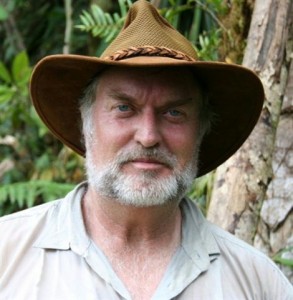 It was his third expedition in Papua New Guinea, but the first one on the mainland. Deep in the mountainous interior, in Tawa Village, at 7:20 p.m., on Nov 9, 2006, Paul Nation videotaped two lights on a nearby ridge. A few weeks later, in Central California, Cliff Paiva (a missile defense physicist) analyzed the video footage, concluding that the two lights were not from any campfires, flashlights, car headlights, meteors, or airplanes. They were also not from any camera artifacts or paste-on hoax. Paiva was unable to resolve the structure that creatured those two lights, for the recording had been done on a typical video camera, not an expensive thermal imaging recorder. But according to his associate living-pterosaur investigators, Paul Nation was the first American to bring back video evidence for living bioluminescent pterosaurs in Papua New Guinea.
It was his third expedition in Papua New Guinea, but the first one on the mainland. Deep in the mountainous interior, in Tawa Village, at 7:20 p.m., on Nov 9, 2006, Paul Nation videotaped two lights on a nearby ridge. A few weeks later, in Central California, Cliff Paiva (a missile defense physicist) analyzed the video footage, concluding that the two lights were not from any campfires, flashlights, car headlights, meteors, or airplanes. They were also not from any camera artifacts or paste-on hoax. Paiva was unable to resolve the structure that creatured those two lights, for the recording had been done on a typical video camera, not an expensive thermal imaging recorder. But according to his associate living-pterosaur investigators, Paul Nation was the first American to bring back video evidence for living bioluminescent pterosaurs in Papua New Guinea.
An article in the Creation Research Society Quarterly (Volume 45, Number 3, “Reports of Living Pterosaurs in the Southwest Pacific”) states:
The first American to bring back video evidence for the bioluminescence of the ropen was Paul Nation, who explored near Tawa Village in late 2006. He saw a number of flying lights on several nights and videotaped, for about fifteen seconds, two lights that were on a ridge where there were no roads, cars, or campfires.
According to Wikipedia (English Wikipedia: “ropen”):
In late 2006, Paul Nation, of Texas, explored a remote mountainous area on the mainland of Papua New Guinea. He videotaped two lights that the local natives called ‘indava.’ Nation believed the lights were from the bioluminescence of creatures similar to the ropen of Umboi Island.
From Searching for Ropens (second edition, nonfiction book):
[We] “saw one yellow glow start from a small glow to a bright glow and then a second appearance start and increase in intensity. The second and higher up the mountain glow, flew up and over the ridge and out of sight. While the first glow went out. 10 pm saw a single yellow glow flying along the mountain ridge to the east of our location following the terrain up and down going south to north.”
From Live Pterosaurs in America (nonfiction book, published in 2009):
On the Papua New Guinea mainland, in 2006, Paul Nation and his associate, native minister Jacob Kepas, explored deep in the highland interior. One night, Paul videotaped two glowing objects at the top of a ridge. The natives attribute this kind of light to large flying creatures that used to carry away animals and children from their village.
More resources:
Giant Bat and ropen of Papua New Guinea
Problems with a bat interpretation (this blog site)
Paul Nation, the most active LP explorer (another blog on living pterosaurs)



 Brian Hennessy
Brian Hennessy